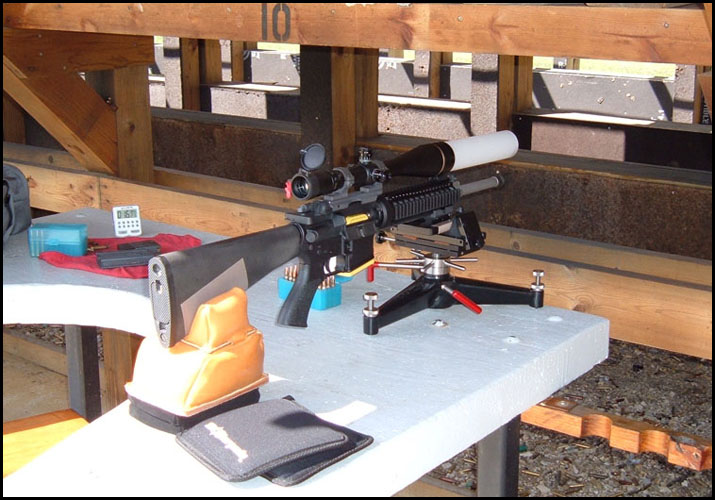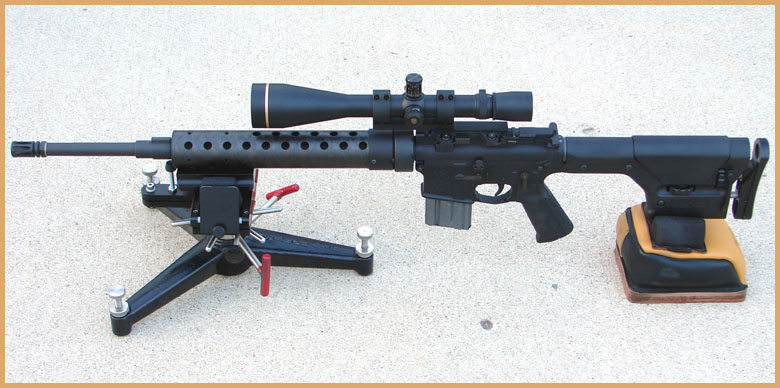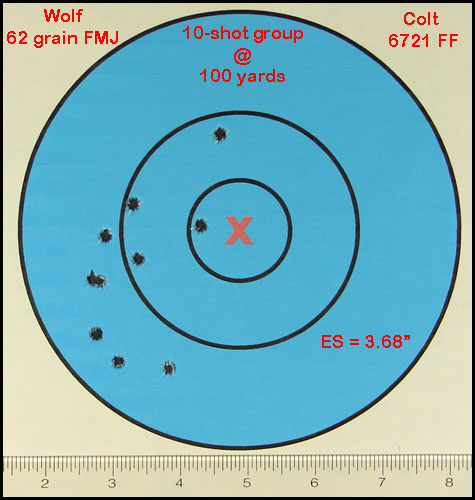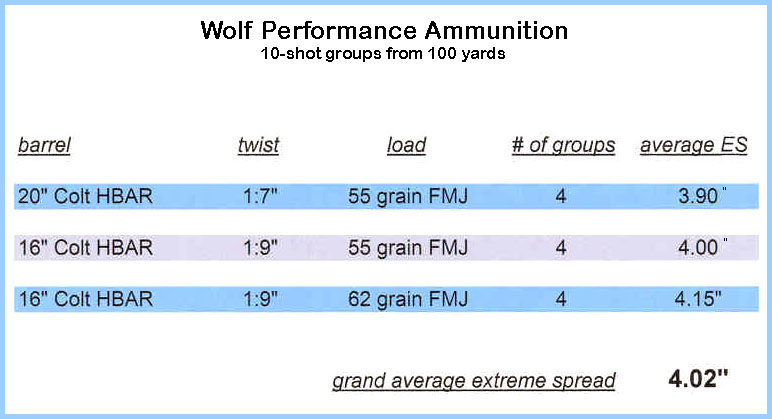The Wolf of Truth
By: MOLON

In this article, we’ll be taking a look at the actual level of
accuracy (technically precision) that is consistently achievable with
the ubiquitous Wolf Performance Ammunition when fired from a
chrome-lined, NATO chambered, semi-automatic AR-15. The “Performance
Ammunition” evaluated for this article is loaded in polymer-coated steel
cases and uses full metal jacket bullets with “bimetal” jackets; a
three-layered affair consisting of a very thin outer layer of copper, a
thick middle layer of steel and another thin layer of copper forming the
inside of the jacket.
The "bimetal" jacket.

This accuracy evaluation used statistically significant shot-group
sizes and every single shot in a fired group was included in the
measurements. There was absolutely no use of any Group Reduction
Techniques (e.g. fliers, target movement, Butterfly Shots). The
shooting set-up will be described in detail below. As many of the
significant variables as was practicable were controlled for. Also,
"control groups" were fired from the barrels used in the evaluation
using match-grade hand-loaded ammunition; in order to demonstrate the
capability of each barrel. Pictures of the fired shot-groups will be
posted for documentation.
All shooting was conducted from a concrete bench-rest from a
distance of 100 yards (confirmed with a laser rangefinder.) The barrels
used in the evaluation were free-floated. The free-float handguards of
the rifles rested in a Sinclair Windage Benchrest, while the stock of
the rifles rested in a Protektor bunny-ear rear bag. Sighting was
accomplished via a Leupold VARI-X III set at 25X magnification and
adjusted to be parallax-free at 100 yards. A mirage shade was attached
to the objective-bell of the scope. Wind conditions on the shooting
range were continuously monitored using a Wind Probe. The set-up was
very similar to that pictured below.

The Wind Probe.

The first Wolf Performance load evaluated was the 55 grain FMJ
version. The test vehicle was a 20” Colt HBAR with a 1:7” twist,
chrome-lining and a NATO chamber. A 10-shot control load was fired from
this barrel at 100 yards using hand-loaded Sierra MatchKings. The
extreme spread of that group was 1.03”.


Four 10-shot groups of the 55 grain FMJ Wolf ammunition were fired in a row from 100 yards with the resulting extreme spreads:
for a 10-shot group average extreme spread of 3.9”. All four of the 10-shot groups were over-layed on each other using RSI Shooting Lab to form a 40-shot composite group. The mean radius for the composite group was 1.16”.
The “smallest” 10-shot group.

The 40-shot composite group.

Knowing that the Internet Commando would feel that the above
evaluation was unfair, due to his false belief that a 1:7” twist barrel
“over-stabilizes” 55 grain bullets, I repeated the entire evaluation
using a 1:9” twist barrel. The results were nearly identical.
The new test vehicle was a 16” Colt HBAR with chrome lining, a NATO
chamber and of course the 1:9” twist. This is the barrel found on the
Colt 6721 carbine. This barrel was also free-floated. The exact same
lot of Wolf 55 grain FMJ ammunition was used for this repeated
evaluation. All other aspects of the evaluation were exactly as
described above for the previous evaluation.

A 10-shot control group fired from the 16” Colt HBAR from 100 yards
using the same match-grade hand-load of Sierra 55 grain BlitzKings had
an extreme spread of 0.89”.
Just as before, four 10-shot groups of the 55 grain FMJ Wolf
ammunition were fired in a row from 100 yards. The extreme spread of
those groups measured:
for a 10-shot group average extreme spread of 4.0”. As before, all
four of the 10-shot groups were over-layed on each other using RSI Shooting Lab to form a 40-shot composite group. This composite group had a mean radius of 1.21”.
The “smallest” group from the 1:9” twist barrel.

The 40-shot composite group from the 1:9” twist barrel.

Here are both of the 40-shot composite groups side by side for comparison. So much for the “overstabilization” nonsense.

Wolf also markets a 62 grain FMJ version of the steel case, bimetal
jacket Performance Ammunition. An accuracy evaluation of this load was
conducted exactly as described above using the same 1:9” twist, 16” Colt
HBAR. Four 10-shot groups of the 62 grain FMJ load were fired from the
bench-rest set-up at 100 yards. The extreme spreads of those groups
measured:
for a 10-shot group average extreme spread of 4.15”. These four 10-shot groups were over-layed on each other using RSI Shooting Lab to form a 40-shot composite group which had a mean radius of 1.22”.
The “smallest” 10-shot group of the 62 grain load.

The 40-shot composite group of the 62 grain load.

To summarize the above accuracy evaluations of the Wolf, steel case,
bimetal jacket ammunition; a combined total of twelve, 10-shot groups
fired from two different barrels using two different lots/weights of the
Wolf ammunition had a grand average extreme spread of 4.02” at 100
yards.

Last, but not least, here’s a picture of the only group that the
Internet Commando would have posted after firing the Wolf, steel case,
bimetal jacket ammunition. It’s a sub-MOA group fired from 100 yards
using the Wolf 62 grain FMJ load; a cherry-picked, 3-shot group, that is.

Wolf 75 grain HP: Lot - B

As I’m sure you all know, Wolf is now distributing a 223 Remington,
75 grain hollow point version of their metal cased, “bi-metal” jacketed
bullet ammunition. While the 75 grain bullet does indeed have an open
tip at the meplat, it is not exactly a typical hollow point design as
the base of the bullet is also open, with exposed lead, as in the
configuration of a full metal jacketed bullet.

I purchased a new lot of the Wolf 75 grain hollow point Performance
Ammunition and performed an accuracy (technically precision) evaluation
of it in the same manner as described above. For this evaluation I used
the same 20” Colt HBAR described above. The rest of the set-up was
basically identical in capability to that described previously,
including front and rear rests and a Leupold VARI-X III set at 25X
magnification. As always, the wind conditions were monitored using a
Wind Probe.

Five 10-shot groups of the Wolf 75 grain HP load were fired in a row
from the bench at a distance of 100 yards. The extreme spreads for
those five groups measured:
- 3.41”
- 6.09”
- 3.59”
- 5.43”
- 4.63”
for a 10-shot group average extreme spread of 4.63”. Over-laying
all five groups on each other using RSI Shooting Lab produced a 50-shot
composite group with a mean radius of 1.24”.
The “smallest” 10-shot group.

The 50-shot composite group.





















